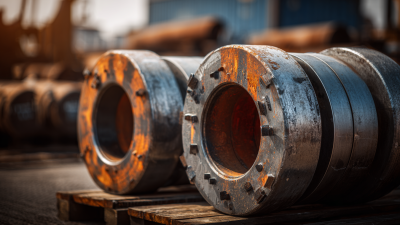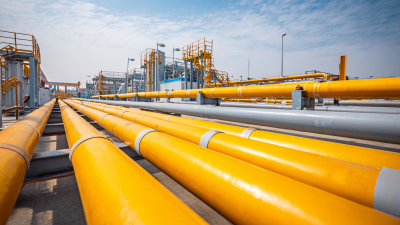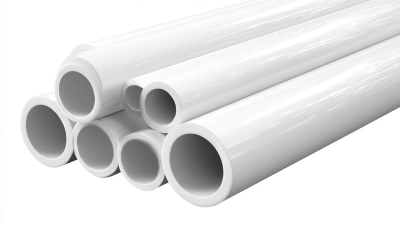Email Id: sale@adctooling.com
In the ever-evolving landscape of industrial projects, selecting the right materials is crucial for ensuring efficiency, safety, and longevity, particularly when it comes to industrial pipe applications. According to recent industry reports, the global industrial pipe market is projected to reach USD 226.77 billion by 2025, growing at a CAGR of 6.3%. This substantial growth underscores the vital role that pipe materials play in various sectors, from oil and gas to chemical processing and water management. Different materials, such as stainless steel, PVC, and carbon steel, offer unique properties that can significantly impact project outcomes. As industries continue to demand higher performance and durability, understanding the key strategies for selecting the appropriate industrial pipe materials becomes increasingly essential for project success. This guide aims to equip you with the knowledge necessary to navigate this critical decision-making process effectively.

Selecting the right industrial pipe materials is crucial for ensuring the safety and longevity of various projects. Several factors influence this choice, particularly concerning the material's resistance to corrosion, structural integrity, and overall performance under specific conditions.
 For instance, the susceptibility of certain pipe materials to corrosion can be a significant predictor of their lifespan, especially in long-distance gas pipelines where extended avalanche destruction incidents often occur.
Understanding how environmental conditions and stress concentrations impact these materials can help in making informed decisions for industrial applications.
For instance, the susceptibility of certain pipe materials to corrosion can be a significant predictor of their lifespan, especially in long-distance gas pipelines where extended avalanche destruction incidents often occur.
Understanding how environmental conditions and stress concentrations impact these materials can help in making informed decisions for industrial applications.
Additionally, the interaction between pipe materials and water chemistry plays a vital role in assessing their suitability for projects related to water supply. Recent studies have highlighted how different materials, such as copper and plastic, can affect lead release into drinking water, which underscores the importance of evaluating water quality alongside material selection.
Moreover, microbial factors, such as biofilm development on various pipe materials, can influence the overall effectiveness and safety of water transportation systems. It's essential to consider these biological interactions when evaluating industrial pipe options, ensuring a holistic approach to material selection that addresses both physical and chemical environmental impacts.
When selecting industrial pipe materials for various projects, it is crucial to understand the properties and ideal applications of common materials like steel, PVC, and copper. Steel pipes are known for their strength and durability, making them an excellent choice for high-pressure applications. They can withstand extreme temperatures and are resistant to corrosion when properly treated, which is why they’re widely used in industries such as oil and gas. However, their weight and higher installation costs may be a consideration for some projects.
On the other hand, PVC (polyvinyl chloride) pipes are valued for their lightweight nature and resistance to corrosion and chemicals. This makes them ideal for plumbing and drainage systems, where ease of installation and low maintenance costs are paramount. PVC pipes also have lower thermal conductivity, which can be beneficial in preventing heat loss in certain applications. Lastly, copper pipes offer excellent thermal conductivity and are often used in water supply and HVAC systems. They are resistant to bacteriological growth, but factors such as cost and susceptibility to corrosion in certain environments should be carefully evaluated when opting for copper. Each material brings unique benefits, and understanding these can lead to better project outcomes.
| Material | Strength | Corrosion Resistance | Cost | Temperature Resistance | Applications |
|---|---|---|---|---|---|
| Steel | High | Moderate | Medium | Up to 400°F (204°C) | Oil, gas, and water transmission |
| PVC | Moderate | Good | Low | Up to 140°F (60°C) | Drainage, irrigation, and chemical handling |
| Copper | Moderate | Excellent | High | Up to 300°F (149°C) | Water supply, HVAC, and plumbing |
When selecting industrial pipe materials, understanding pipe pressure ratings is crucial. These ratings indicate the maximum pressure that a pipe can withstand under specific conditions without failure. According to the American National Standards Institute (ANSI), pipe materials are classified into various pressure classes based on their ability to handle internal pressure, temperature, and external forces. For instance, PVC pipes typically have maximum pressure ratings ranging from 100 to 400 PSI, making them suitable for low to medium pressure applications. Conversely, carbon steel pipes can endure significantly higher pressures, often exceeding 2,000 PSI, making them a preferred choice for high-pressure processes in industries such as oil and gas.

The influence of temperature on pipe performance cannot be overlooked. The Plastic Pipe Institute's latest guidelines indicate that as temperatures rise, the pressure rating of plastic pipes decreases. For example, a PVC pipe rated at 100 PSI at 73°F may only handle 60 PSI at 140°F. Hence, selecting the appropriate pipe material not only requires an understanding of pressure ratings but also a thorough evaluation of the operational environment. Experts suggest performing a detailed analysis of both pressure and temperature conditions to ensure the longevity and safety of the piping system, thus minimizing the risk of leaks or catastrophic failures.
When selecting industrial pipe materials for projects, the analysis of costs should extend beyond the initial investment, particularly when considering long-term value. Recent industry reports highlight that life cycle cost analysis (LCCA) plays a crucial role in evaluating total expenditures over a pipe's lifespan, encompassing maintenance, energy use, durability, and potential replacement costs. For example, utilizing high-grade materials might result in a higher upfront cost, but the savings incurred due to reduced maintenance and enhanced durability can offer significant advantages in the long run.
Moreover, understanding the economic implications of pipe material choices can align with broader market trends, such as the ongoing global energy transition. As highlighted in the Global Energy Perspective 2024, the energy sector is on the brink of significant changes, impacting material demands and operational costs. This shift can drive the necessity for durable and sustainable materials, reinforcing the case for a comprehensive cost analysis that includes not just the initial outlays but also environmental impact and long-term operational reliability. By applying these insights from LCCA and current market dynamics, project managers can make informed decisions that balance initial investment with future value.
When selecting industrial pipe materials, regulatory standards and compliance considerations play a pivotal role in ensuring safety and efficiency. Different industries, including oil and gas, chemical processing, and water supply, are governed by strict regulations set by organizations such as the American Society of Mechanical Engineers (ASME) and the American National Standards Institute (ANSI). According to a report by MarketsandMarkets, the global industrial pipe market is projected to grow from USD 4.5 billion in 2020 to USD 5.7 billion by 2025, underscoring the increasing importance of compliance in material selection.
Compliance with standards such as ASTM International guidelines ensures that the materials used can withstand various environmental conditions and stresses. For instance, materials like carbon steel and stainless steel provide high durability and corrosion resistance, which are vital for maintaining pipeline integrity. The National Association of Corrosion Engineers estimates that corrosion costs industries over $276 billion annually, emphasizing the financial incentive for adhering to these standards. Thus, understanding regulatory requirements is essential for selecting the right materials that not only meet performance expectations but also adhere to legal and safety standards in the industrial sector.





